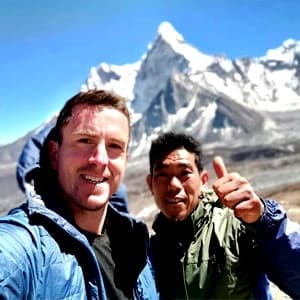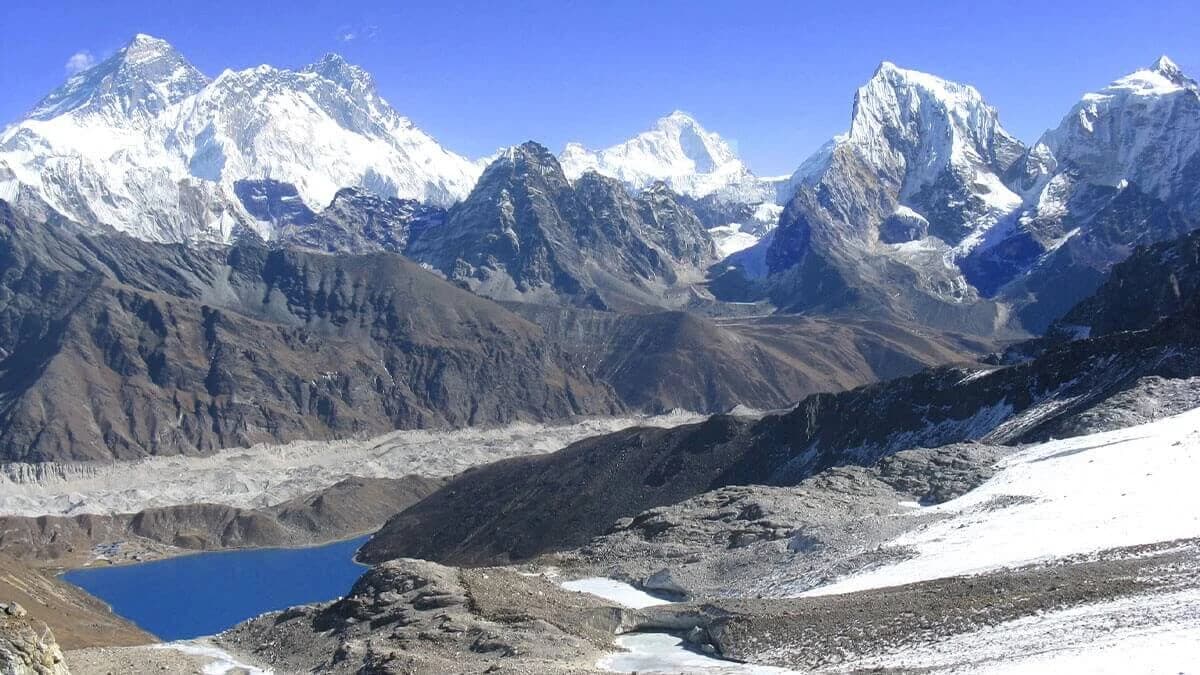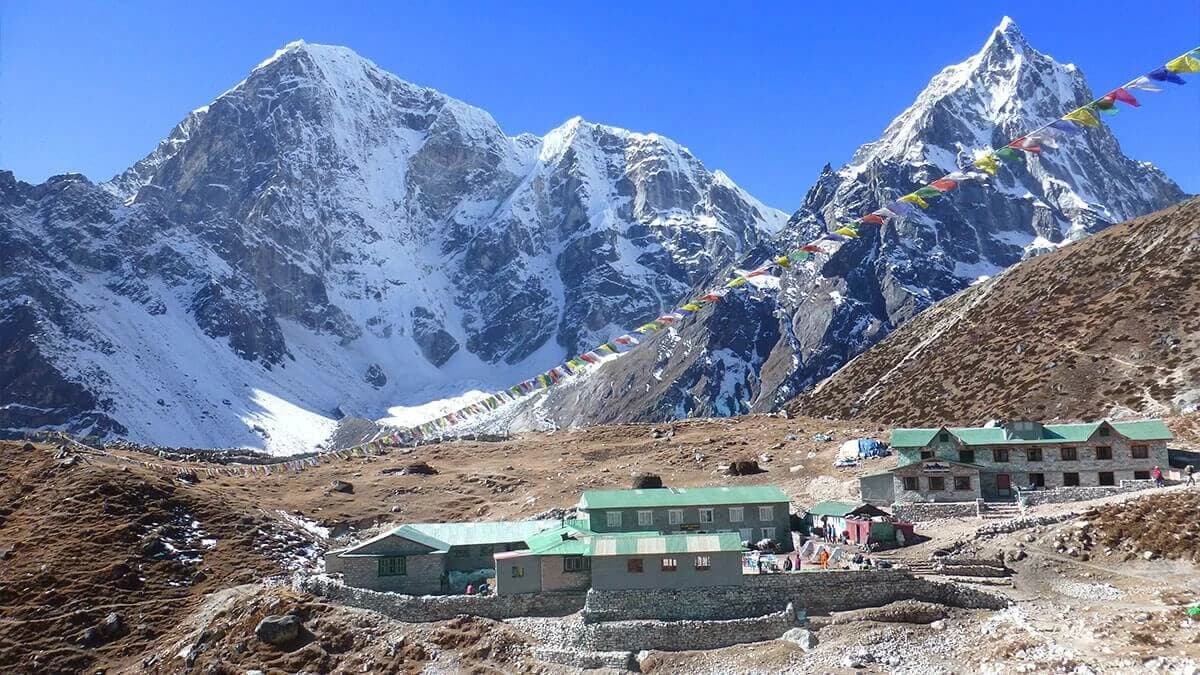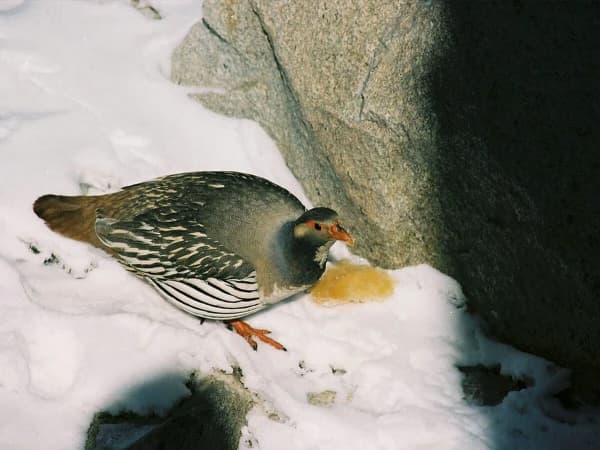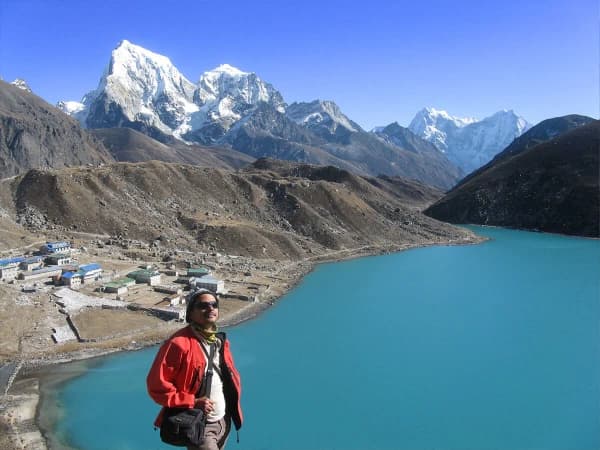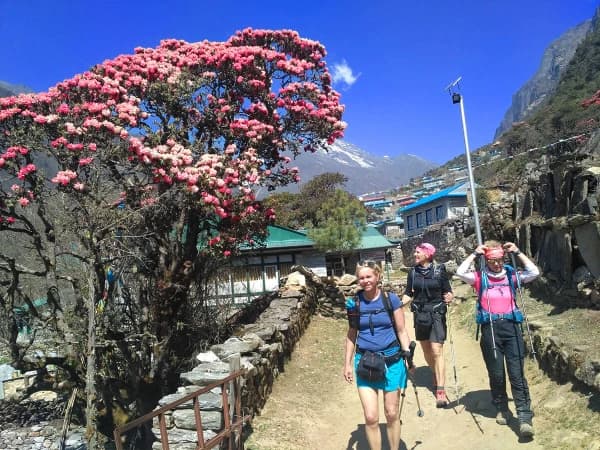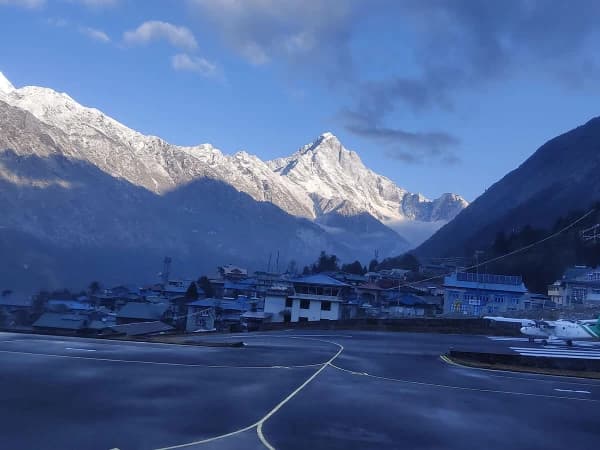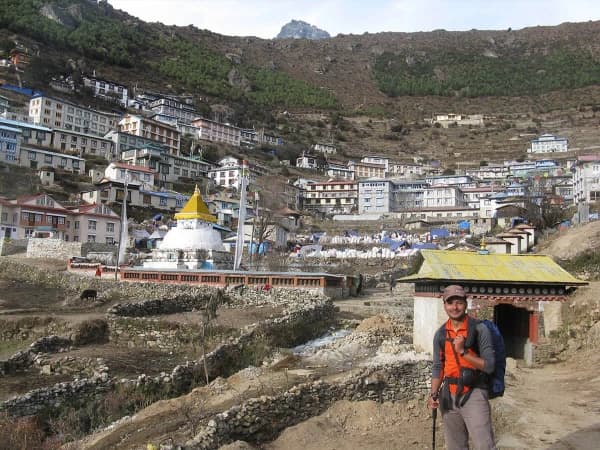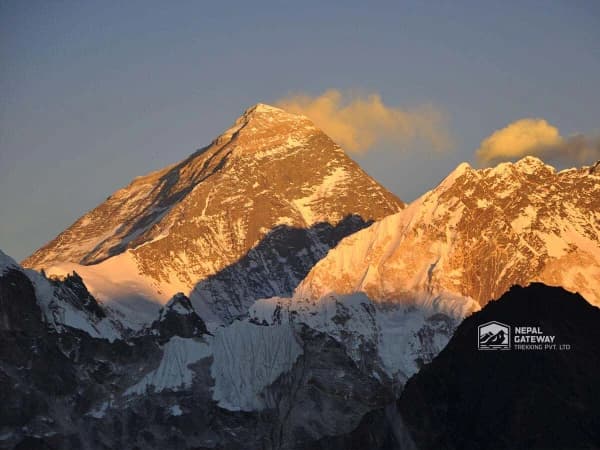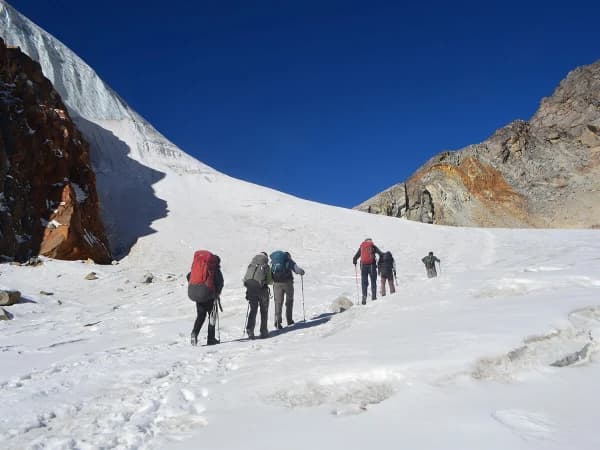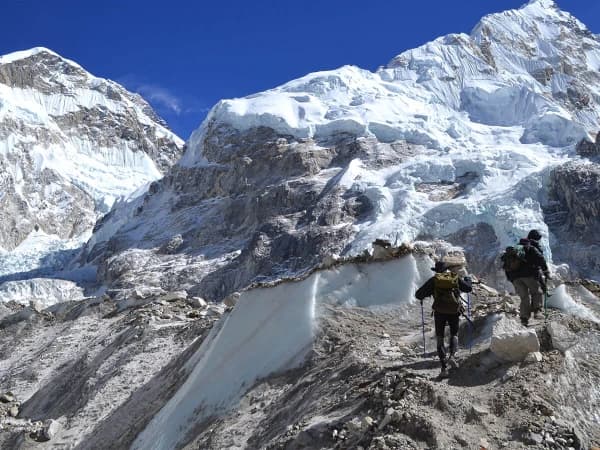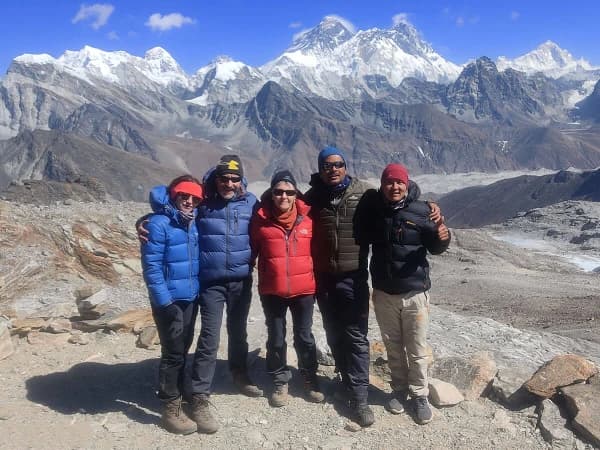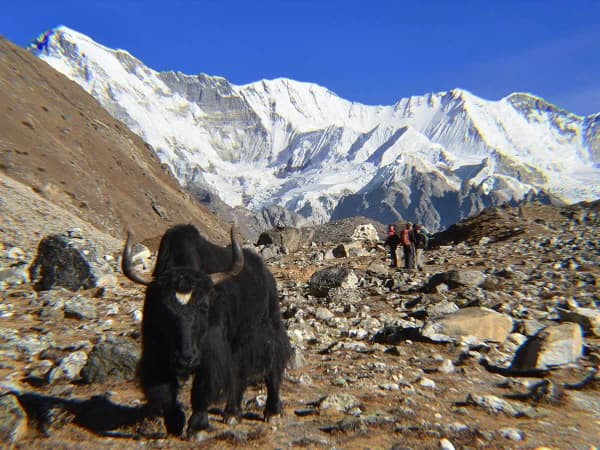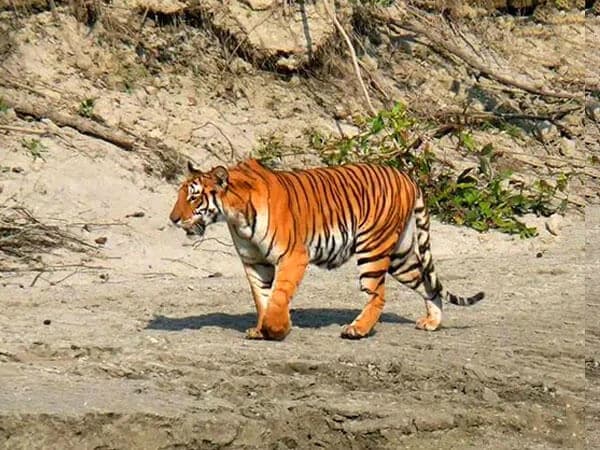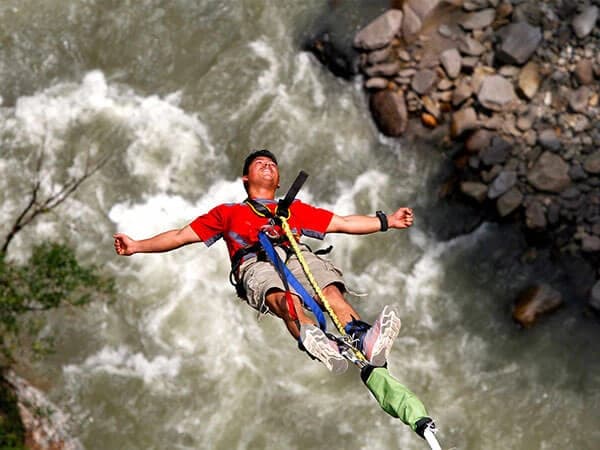The Everest Three High Passes Trek is the most adventurous trip in the Everest region. It encompasses seven points above 5,000 meters: Cho La, Renjo La, Kongma La, Chhukung Ri, Gokyo Ri, Everest Base Camp, and Kala Patthar.
Everest High Passes Trek
Everest High Passes trek is Nepal's ultimate Everest region adventure. You'll cross three major passes: Kongma La (5,535 m), Cho La (5,420 m), and Renjo La (5,340 m). This 19-day journey takes you to Everest Base Camp (EBC), Gokyo Lakes, and Kala Patthar viewpoint.
You'll see Mount Everest, Lhotse, Makalu, and Cho Oyu up close. Choose this trek for the best mountain views and the ultimate Himalayan challenge.
This trek became famous after Hillary and Tenzing's 1953 Everest summit. Adventure seekers wanted more than the basic Everest base camp route. The Three High Passes trek was developed in the 1990s and 2000s. Local Sherpas built teahouses along the way. Now, it's one of the world's most popular high-altitude treks.
The Everest 3 High Pass journey passes through Sagarmatha National Park. The park protects 1,148 square kilometers of Himalayan wilderness. You'll spot snow leopards, red pandas, and Himalayan black bears. The landscape changes from green forests to rocky glacial terrain. Rhododendron trees bloom at lower elevations. Higher up, hardly any alpine plants survive. Ancient glaciers and pristine lakes create stunning scenery.
You'll experience rich Sherpa culture throughout this high-altitude trek. Visit ancient monasteries like Khumjung, Tengboche, and Pangboche. Stay in traditional stone houses with warm Sherpa families. The Sherpas have lived at high altitude for centuries. Their Buddhist traditions and mountain skills are legendary.
This 19-day adventure combines extreme mountain passes with deep cultural experiences. The Everest 3 High Passes Trek is an unforgettable journey that tests your limits and rewards you with memories of a lifetime.
Major Highlights of Everest Three High Passes Trek
- Cross three legendary high passes – Renjo La (5,340 m), Cho La (5,420 m), and Kongma La (5,535 m).
- Visit Everest Base Camp – Stand at the base of the world's highest mountain.
- Climb Kala Patthar – Best vantage point for a close-up of the Mount Everest summit views.
- Explore Gokyo Lakes – Trek to pristine turquoise glacial lakes and Gokyo village.
- Summit Gokyo Ri – Panoramic vistas of four 8,000 m peaks, including Everest, Lhotse, Makalu, and Cho Oyu.
- Experience Sherpa Culture – Visit traditional villages and monasteries and interact with local communities.
- Cross massive glaciers – Trek across Ngozumpa and Khumbu glaciers.
- Visit Namche Bazaar – Explore the vibrant "Gateway to Everest" with modern amenities.
- See iconic suspension bridges – Cross thrilling Hillary Bridge and other famous Himalayan bridges.
- Complete circuit route – Avoid retracing steps with this challenging loop trek.
- Witness a diverse landscape – from lush forests to high alpine terrain and glacial valleys.
- Challenge yourself – One of the most demanding treks in the Everest region for experienced trekkers.
- 360-degree mountain scenery – Spectacular panorama of the world's highest peaks throughout the journey.
Route Overview of Everest Three Passes Trekking
The adventure begins in Kathmandu, where you'll complete trek preparation, including permit arrangements and gear checks. After a thrilling flight to Lukla, the Everest High Pass Trekking officially starts. The trail descends through traditional Sherpa settlements, passing through Monjo, where park authorities thoroughly check trekking permits.
You'll spend the first night in Phakding, a peaceful village that is an ideal introduction to the Khumbu region. The journey continues towards Namche Bazaar, crossing numerous suspension bridges, including the famous Hillary Bridge over the Dudh Koshi River. Namche, the bustling Sherpa capital, offers staggering mountain vistas and is the first acclimatization stop.
During the rest day, you'll hike to vantage points like the Hotel Everest View and explore the traditional villages of Khumjung and Khunde. These side trips help with altitude adjustment while providing insights into Sherpa culture and lifestyle.
From Namche, the path comes across Tengboche village, home to the region's most significant monastery, where you can witness Buddhist ceremonies and enjoy panoramic Himalayan vistas. The trek continues to Dingboche, another crucial acclimatization point where you'll take a rest day hiking toward Nagarjun Peak (also known as Nangkartshang Peak). This side trip offers fine-looking views and helps prepare your body for high altitudes ahead.
Departing from the main Everest base camp trail, the course leads to Chukhung, a small settlement beneath towering peaks. From here begins the most challenging part of the trek as you cross Kongma La Pass (5,535 m), one of the three high passes that define this expedition. The pass crossing requires early morning starts and careful navigation, rewarding you with eye-catching panoramas before descending to Lobuche, where the path rejoins the classic EBC trail.
The trek reaches its pinnacle as you hike to Gorak Shep and then to Everest Base Camp (5,364 m) itself. Standing at the base of the world's highest mountain, you'll witness the bustling preparation area where climbers begin their summit attempts. The dramatic Khumbu Icefall and towering peaks surround the base camp.
The following morning brings an early ascent to Kala Patthar (5,555 m), offering the trip's most amusing sunrise views over Everest, Lhotse, and Nuptse. This vantage point provides the clearest and most iconic sights of Mount Everest's summit.
The adventure continues with a trek to Dzongla, crossing the technical Cho La Pass (5,420 m), the second of the three high passes. This demanding section requires navigating uneven paths and possibly trekking over ice, followed by a descent into the village of Thagnak. From here, you'll reach the pristine Gokyo Valley and the turquoise Gokyo Lakes, considered among the world's highest freshwater lake systems.
You'll climb Gokyo Ri (5,360 m) at Gokyo village for breathtaking panoramic vistas of four 8,000-meter peaks: Everest, Lhotse, Makalu, and Cho Oyu. The final high pass crossing takes you over Renjo La Pass (5,340 m) to Lungden, completing the trilogy of challenging mountain passes. This pass offers stunning sights of the Rolwaling range and Everest's north face before beginning the long descent back to familiar territory.
The return journey retraces steps through Namche Bazaar, allowing time to reflect on the incredible achievement while enjoying the thicker air of a lower altitude. After reaching Lukla, you'll fly back to Kathmandu for a well-deserved rest and celebration dinner.
The trek concludes with your departure flight home, carrying memories of having conquered three of the Everest region's most challenging high passes, witnessed the world's highest peak up close, and experienced the warmth of Sherpa hospitality throughout this epic 19-day Three High Passes trek.
Why Choose Nepal Gateway Trekking for the Everest Three High Passes Trek?
- Local Expertise and Authentic Experience: As a locally owned Nepali agency, Nepal Gateway Trekking offers unparalleled insider knowledge of the Everest region. Our team understands the cultural nuances, weather patterns, and trail conditions that only come from growing up in these mountains.
- Experienced Local Guides and Porters: Our guides are certified, English-speaking locals with extensive experience on the Three High Passes route (Kongma La, Cho La, and Renjo La). They provide safety expertise while sharing authentic stories about Sherpa culture and mountain traditions that international agencies cannot match.
- Direct Community Impact: The Everest Three High Passes trek directly supports Nepali families and mountain communities by choosing our local agency. We employ local guides, porters, and support staff, ensuring your adventure contributes meaningfully to the regional economy.
- Cost-Effective Without Compromise: As a local operator, we eliminate international middleman markups while maintaining high safety standards and quality service. You get exceptional value with authentic local experiences.
- Flexible and Personalized Service: Our local presence allows for greater flexibility in customizing the Everest 3-pass trek itinerary, handling last-minute changes, and providing immediate on-ground support throughout the challenging 19-day adventure across the three high passes.
- Deep Safety Knowledge: Our team's intimate familiarity with high-altitude conditions, weather patterns, and emergency protocols in the Everest region ensures safety on this demanding trek that crosses three passes above 5,300 meters.
- Cultural Immersion: Experience genuine Sherpa hospitality and cultural insights that only a local agency can provide, from traditional tea house selections to meaningful interactions with mountain communities along the route.
Itinerary
This is our standard and recommended itinerary for the Everest Three High Passes Trek.
The Everest high pass trip starts in Kathmandu, Nepal's bustling capital city. After transferring to the hotel from the airport, you can freshen up. The trip leader runs through a full briefing of the Everest high passes trek itinerary ahead. He will check your trekking gear and equipment.
Next, head out to explore the city's back street courtyards, markets, and temples to get the first glimpse of this country's rich culture and friendly people. You can dine at one of the local restaurants. If you want trekking gear, you can shop at the nearby locale Thamel.
The Everest Three High Passes trek begins with an exciting flight to Lukla's famous Tenzing-Hillary Airport. The short runway is carved into the mountainside with a dramatic slope, making the landing thrilling. Upon arrival at Lukla, you'll meet the rest of the trekking crew. Enjoy a hearty breakfast before starting the first day of the trek toward Phakding.
The journey continues through ancient groves of blue pine and rhododendron forests. Along the way, you'll see intricately carved mani stones displaying Buddhist prayers and mantras. This is your first taste of the rich Sherpa culture that defines the region.
You'll cross the first suspension bridge today, something you'll do many times throughout the trek. The trail goes through small mountain settlements, including Chheplung, Ghat, Burning, and Thado Koshi.
After a scenic day of walking, you arrive at the charming village of Phakding. This peaceful settlement sits along the banks of the rushing Dudh Koshi River. The town offers a serene mountain atmosphere and a comfortable teahouse for the night. Phakding is the perfect first stop for trekkers heading to Everest Base Camp at this moderate altitude.
Important Note: During the peak season, flights will be operated from Manthali Airport, Ramechhap, to Lukla. In the spring, from mid-March to mid-May and late September to November in the autumn season, all flights take off and land at Manthali Airport.
The Manthali airport, Ramechhap, is 142 km from Kathmandu, a 4-5 hour drive. To catch a flight to Lukla from Ramechhap, you must depart around 1 a.m. to 2 a.m. from Kathmandu.
Begin the morning trek through dense pine and rhododendron forests. The rushing Dudh Koshi River will be your constant companion today. You'll cross several exciting suspension bridges, including the Hillary Suspension Bridge. These swinging metal bridges add adventure to the journey as you make your way upstream.
Along the way, the trail passes through traditional Sherpa hamlets like Benkar, Chimoa, and Monjo. At Monjo village, you'll reach the entrance to Sagarmatha National Park. Before entering this protected area, you must show the Everest high passes trekking permits.
Continue walking to the small settlement of Jorsalle, where you can rest and prepare for the challenge ahead. Little ahead of Jorsalle, the steep ascent begins from Larja Dovan toward Namche. This section is one of the most challenging ascents on the Everest Base Camp trek.
After completing the tough uphill climb, you finally arrive at Namche Bazaar. This vibrant town is one of the largest Sherpa settlements in the Everest region. Known as the "Gateway to Everest", Namche offers a perfect blend of modern amenities and authentic Sherpa culture. You'll find comfortable lodges, internet cafes, and shops selling trekking gear.
Today is the first acclimatization day, and staying active is the best way to adjust to the altitude. Namche Bazaar offers several excellent hiking options for proper acclimatization. Start early by hiking to Hotel Everest View (13,000ft), the world's highest-placed hotel. You'll enjoy the astonishing sights of Mt. Everest and neighboring peaks from every corner of this remarkable hotel.
If you want to explore further, continue to the traditional villages of Khumjung and Khunde. Khumjung sits beautifully beside Mount Khumbila, whose name means 'God of Khumbu'. Many Sherpas consider this sacred peak too holy to climb. Visit the Khunde Hospital and Khumjung School, built by Sir Edmund Hillary after his historic Everest summit.
Don't miss the centuries-old Khumjung monastery, the spiritual center of Sherpa Buddhism. Inside this monastery, you can see a preserved Yeti scalp kept for generations. After exploring these culturally rich settlements, return to the teahouse to rest for tomorrow's trek to Tengboche.
Today, begin the trek with a steep climb from Namche Bazaar. After that, the route becomes gentler, following a wide path along the hillside with some gentle ups and downs. On the way, you pass the Tenzing Norgay Memorial Chorten, where you can see astonishing vistas of Everest, Lhotse, and Ama Dablam. Walking a few kilometers, you reach Kyangjuma, a quiet spot with lovely scenery and a few teahouses.
The path from Kyangjuma descends through a quiet forest to the small town of Phunki Thanga. This riverside settlement offers several places to eat and rest. Take time to recharge here, as the most demanding section of today's trek lies ahead.
After crossing the suspension bridge at Phunki Thanga, the trail climbs steeply uphill with a series of dusty switchbacks. The initial section can be quite tiring. As you continue through a forest, the track becomes easier. At the top, you arrive in Tengboche, a village known for its ancient monastery with a great mountain backdrop.
From Tengboche, the trek goes downhill for a short while to reach Deboche, a quiet place with a few teahouses. Then, the path becomes mostly flat and passes through a lush forest. You walk under trees covered in moss, with lovely sights of the Dudh Koshi River. After crossing a suspension bridge, the trek route gently climbs to Pangboche.
Pangboche is a large settlement with many teahouses, homes, and farming fields. On clear days, the mountain scenery from here is terrific. After leaving Pangboche, the trail comes across a dry hillside. In about an hour, you reach Shomare, a small town with several teahouses and good rest spots.
The trail continues with a slow, steady climb. Further reaching the open valley, the pathways join, leading to a small metal bridge. This is where two rivers meet. After the bridge, the trail climbs a bit more but becomes easier again. Soon, you'll see Dingboche in the distance and reach the village shortly after.
Today is an acclimatization day at Dingboche. To help your body adjust to the altitude, you'll hike to Nangkartshang Peak, which stands at 5,039 meters. The acclimatization hike starts right from the village, behind the French Bakery. As the trail climbs, you'll pass white stupas and small chortens. The uphill walk is steady and offers exceptional views along the way.
The higher you go, the more sublime the scenery becomes. You can see Ama Dablam, Island Peak, and the valley stretching toward Chukhung. The climb's final part is steep, so take your time. At the top, you'll witness colorful prayer flags and sweeping views in all directions. After enjoying the peaceful mountain setting, return to Dingboche for the night.
You leave the main Everest Base Camp route today and head toward Chukhung. The trail is peaceful and less crowded. It's a short walk, but still crucial for acclimatization. The path climbs gently through the open landscape with scattered rocks and low bushes.
You'll walk past stone-walled fields and follow the valley with the Imja Khola River flowing beside. As the path goes higher, new mountain vistas open up. Ama Dablam looks different from this angle, and Island Peak appears as you get closer to Chukhung.
Chukhung is a small hamlet with only a few teahouses. It is quiet and calm, perfect for a restful afternoon. After reaching the town, relax and enjoy the splendid mountain surroundings.
Today, you'll cross Kongma La Pass (5,535m), the highest of the three passes on the Everest Three Passes trek. The trail is long and challenging, but the scenes are photographic. Starting early from Chukhung, you'll first climb a steep hillside. The trail becomes gradual for a while and then climbs again, passing a scenic lake surrounded by mountains.
After resting near the lake, you'll tackle the steepest section of the day — a short but challenging climb on narrow switchbacks. Near the top, the path becomes gentler again before one final push to the pass. At the top, prayer flags mark the pass, and the scenes are eye-popping. You can see Ama Dablam, the Lhotse-Nuptse wall, and the village of Lobuche far below.
The descent from Kongma La is steep and tricky, so walk carefully. After reaching the valley floor, the path climbs onto the rocky Khumbu Glacier. The trail crosses boulders and small glacial lakes marked by cairns and flags. After this, it's a short walk down to Lobuche, where you'll spend the night.
Today, you follow a moderate track to Gorak Shep, the last settlement before Everest Base Camp. The walk is not too difficult, but it can feel tiring due to the thin air at high altitudes. Once you reach Gorak Shep, rest well and have lunch before heading towards Base Camp.
After the break, hike to the base camp of the world's highest peak, Mt. Everest. The trail is jagged and follows the edge of the Khumbu Glacier. If the weather is clear, you'll see amazing scenes of the surrounding Himalayas. Reaching Base Camp is a proud moment — it's the closest point you can get to Mount Everest without climbing.
At Base Camp, get a close look at the Khumbu Icefall and the vast Khumbu glacier. You might also see colorful tents during the climbing season. After enjoying the views and taking photos, return to Gorak Shep for the night.
Start the day very early to hike up Kala Patthar for the sunrise view of Mount Everest. This iconic viewpoint sits at 5,555 meters and offers the best close-up views of Everest's summit. Unlike Everest Base Camp, no other mountains partially block the view from here. The two to three-hour climbing is challenging but absolutely worth the effort.
From the top, you'll see incredible 360-degree panoramas of Everest, Lhotse, Nuptse, Pumori, and Ama Dablam. After capturing this unforgettable moment, trek back down to Gorak Shep for a well-deserved breakfast.
From Gorak Shep, begin the journey toward Dzongla. The trail goes alongside the massive Khumbu Glacier as you retrace the steps toward Lobuche. The course comes across familiar territory until reaching Lobuche. Continue past the Thokla Pass, also known as the Everest Memorial, where prayer flags honor climbers who lost their lives on Everest.
This path offers alluring views of the upcoming Cho La Pass and the quaint Chola Tsho Lake. The scenery becomes more dramatic as you approach Dzongla. Trek alongside the pristine mountain lake before finally reaching Dzongla.
This remote settlement serves as the base for tomorrow's challenging crossing of Cho La Pass. Rest well tonight as you prepare for one of the trek's most demanding days.
Today marks one of the most exciting days of the Three High Passes trek. You'll cross the challenging Cho La Pass at 5,420m, the second of three legendary high passes. Start very early, as a long and demanding day awaits you.
The path to the pass is uneven, requiring careful footwork on the rugged terrain. The high altitude may make the climb more difficult, but the efforts will be rewarded at the top.
Once you reach Cho La Pass, the breathtaking scenery will leave you spellbound. From this vantage point, you'll see the magnificent Ama Dablam, towering Lhotse, and the pristine Cho La Lake far below. Take time to celebrate this major achievement and capture photos of the dramatic mountain panorama. The prayer flags fluttering in the wind mark you successfully crossing this challenging pass.
After enjoying the jaw-dropping scenes, begin the descent toward Thagnak. The downhill trail is much easier than the ascent but requires caution on the slippery, mountainous sections. Watch your foot carefully as you make your way down the steep terrain.
Thagnak is a small settlement with just a few basic teahouses for trekkers. While most people continue directly to Gokyo village, you'll spend the night here to rest and recover from today's challenging pass-crossing.
Today's trek leads to the beautiful Gokyo Valley, home to the famous pristine Gokyo Lakes. This peaceful settlement sits on the eastern shore of Gokyo Cho, also called Dudh Pokhari. This is the third and the largest of the six well-known glacial lakes in the area. The village offers splendid views and is the perfect base for exploring the surrounding high-altitude lakes.
The journey takes you across the massive Ngozumpa Glacier, one of the longest glaciers in the Himalayas. The hike is tough, with frequent ups and downs over rough ground filled with large boulders. The route follows a rocky ridge alongside the glacier before falling sharply downhill. Be careful while crossing the glacier, as hidden crevasses can be dangerous.
Nearing the end of the trek, Gokyo village comes into view, nestled peacefully by the shimmering turquoise lake. The calm waters of Gokyo Lake reflect the towering peaks that rise all around, creating a magical scene. It'll be a rewarding moment after such a long day's journey. Finally, you arrive at Gokyo Village, where you'll stay for two days to explore and acclimate.
The acclimatization day at Gokyo Village is essential for your body to adjust to the high altitude. It also gives you a chance to explore the beautiful surroundings. On this day, you'll hike to the top of Gokyo Ri, which stands at about 5,360 meters.
The climb to Gokyo Ri is steep but rewarding. From the top, savor enthralling views of the Everest region. Peaks like Everest, Lhotse, Makalu, and Cho Oyu rise high in the sky. Below, relish the sight of the deep blue Thongak Tsho and Ngozumpa Tsho Lakes.
After the hike, relax and enjoy the peaceful Gokyo Valley. If you still have energy, a short walk leads to Scoundrel's Viewpoint or towards Fifth Gokyo Lake. These spots offer wondrous views of glaciers, lakes, and snow-covered peaks.
Today, you leave Gokyo Village and head towards Lungden by crossing the Renjo La Pass. The day begins with a steep climb along a rocky terrain. As the trail gains height, the scenery becomes more and more flawless. You can see the entire Gokyo Valley and the turquoise lakes below.
Though still challenging, the well-marked trail offers steady climbing conditions. En route, you might spot local herders in the high pastures with their yaks. Reaching the top of Renjo La Pass is the main highlight of the day.
From here, you get one of the best scenic views of the Everest region. Snowy peaks like Everest, Lhotse, and Cho Oyu rise tall in the distance. Plus, you can see the turquoise waters of Dudh Pokhari, the third of Gokyo's famous Lakes. It's a perfect place to rest and take photos before descending.
After enjoying the views, begin the long walk down to Lungden. The routeway goes through rough paths and stone steps. The path passes pastures, small streams, and stone huts on the way. Finally, you reach Lungden, a quiet village where you rest for the night.
Begin the walk with a descent from Lungden toward the peaceful village of Marlung, nestled along the banks of the Bhote Koshi River. This scenic spot offers a perfect rest stop where you'll likely encounter fellow trekkers returning from Renjo La Pass. Take time to admire the surrounding rolling hills and distant snow-capped peaks before continuing a journey.
Further, the trail leads downhill to the historic village of Thame, crossing multiple bridges over the rushing Bhote Koshi River. Thame holds special significance as the birthplace of legendary mountaineers, including Tenzing Norgay, the first person to summit Mt. Everest alongside Edmund Hillary. Visit the ancient Thame monastery perched dramatically on a hillside overlooking the valley.
From here, continue a descent through traditional Sherpa settlements, including Samde, Mende, and Phurte, crossing the river several more times. After days in remote mountain hamlets, you'll finally arrive in the vibrant town of Namche Bazaar, where modern comforts like internet access and hot showers await after the wilderness adventure.
Today, the path leads back to Lukla through the pleasant Dudh Koshi Valley from Namche Bazaar. The trail is downhill, traversing through familiar territory you walked on the first day. You'll cross several suspension bridges. The descent passes through lush, high-altitude forests filled with pine and rhododendron trees. This forest bursts into vibrant colors during spring with blooming rhododendrons, creating a gorgeous natural display.
Likewise, the path retraces the original route through the settlements you visited at the start of the trek. Since this is the final day on the Everest trail, make every moment count. Take time to appreciate these mountain giants, traditional mani stones, and warm Sherpa hospitality one last time.
Arrive in Lukla with mixed feelings of accomplishment and sadness that the 3-passes adventure is ending. After weeks in remote high-altitude villages, this bustling mountain town will feel quite different. Get to bed early tonight, as you have an early morning flight to Kathmandu tomorrow.
The Three High Passes trek concludes with a scenic flight from Lukla to Kathmandu. Wake early for the morning departure, though mountain weather can be unpredictable and may cause delays. The short but spectacular flight offers one final glimpse of the majestic Himalayan peaks. As a plane soars above the towering mountains, reflect on the Everest three-pass journey you've just completed.
This day serves as a buffer for possible weather-related flight delays, helping you stay on track for your international travel plans. Upon landing in Kathmandu, you'll leave behind the magnificent Everest region and its towering giants. If the flight departs on schedule, you'll have the afternoon and evening to explore Nepal's vibrant capital city. A guide can recommend the best activities based on your interests, whether visiting ancient temples, shopping for souvenirs, or enjoying authentic Nepali cuisine.
This final day allows you to unwind from a high-altitude adventure and gradually transition back to everyday life. The memories of crossing three legendary passes and experiencing the raw beauty of the Himalayas will stay with you forever.
The remarkable 19-day Everest Three High Passes trek comes to an end today. A representative from Nepal Gateway Trekking will escort you to the international airport three hours before your scheduled departure. You'll have plenty of time for check-in procedures and any last-minute shopping at the airport.
Your journey through the world's highest mountains is complete, and it's time to return home with a heart full of memories. As you prepare for your journey home, carry the spirit of the Himalayas and the confidence gained from this extraordinary adventure.
We look forward to welcoming you back for future explorations in Nepal, Bhutan, or Tibet. Until we meet again, safe travels, and thank you for choosing us for this unforgettable Himalayan experience.
Dates & Availability
Private tripCost Includes
- All ground transportation as per itinerary by private car.
- Two nights’ accommodation at a three-star category hotel in Kathmandu, inclusive of breakfast.
- Round-trip flight ticket (Kathmandu/Lukla/Kathmandu or Ramechhap/Lukla/Ramechhap) inclusive of domestic airport taxes.
- Three meals (breakfast, lunch, and dinner) on the trek.
- Accommodations during the trekking.
- One highly experienced, English-speaking, friendly trekking guide and his expenses
- Required porters (1 porter between 2 trekkers), including their expenses.
- Sagarmatha National Park permit and TIMS card.
- Everest Three High Pass Trekking Map.
- Nepal Gateway Company T-shirt.
- Nepal Gateway Trekking Company's duffle bag for trekking.
- Local fresh fruits as desserts.
- First aid kit with oximeter.
- Evacuation assistance if needed.
- Government taxes.
- Office service charge.
Cost Excludes
- Lunches and dinners in Kathmandu.
- Your travel insurance.
- Nepal entry visa.
- Your international flight ticket to/from Kathmandu.
- All kinds of hot drinks (tea, coffee, and hot water)
- Cold drinks (mineral water, Coke, and Fanta) and alcoholic beverages on trekking.
- Your personal nature expenses, equipment, and medical kit.
- Hot shower, internet, and phone call unless it is free.
- Tipping to field staff (tipping is not mandatory but expected).
Good To Know
Everest Three High Passes Trek Cost
The Everest Three High Passes trek costs between USD 1645 and USD 1400 per person. This price range depends on the trekking season, group size, and duration. Solo trekkers generally pay more than those in groups. The cost also varies based on your preferred comfort level and service quality. Peak seasons like spring and autumn usually command higher prices due to increased demand.
The Everest 3 high passes trekking package covers essential services, including airport transfers, teahouse accommodation, three meals daily, trekking permits, and guide/porter fees.
However, you'll need an additional budget for personal expenses during the trek. Hot showers, internet access, device charging, bottled water, and tips for guides and porters are extra costs. Plan to spend USD 25-30 per person daily for these amenities throughout the trek.
Before departing, budget for pre-trek expenses that aren't included in packages. You'll need proper trekking gear and equipment, comprehensive travel insurance, international flights to Nepal, and visa fees. These preparatory costs can add significantly to the total expedition budget. Consider renting gear in Kathmandu to reduce upfront equipment costs if you don't plan regular trekking.
Cost Breakdown Summary
| Cost Category | Amount (USD) | Details |
| Basic Trek Package | USD 1500 - USD 3000 | Transportation, accommodation, meals, permits, flight tickets, guide and porters |
| Daily Extra Expenses | USD 25 - USD 30/day | Hot shower, internet, charging, hot & cold drinks, snacks, tips |
| Pre-Trek Gear | USD 500 - USD 1500 | Clothing, sleeping bags, boots (rental equipment) |
| Travel Insurance | USD 100 - USD 300 | Comprehensive coverage, including helicopter rescue |
| International Flight | USD 800 - USD 2000 | Varies by departure location and trekking season in Nepal |
| Nepal Visa | USD 40 - USD 125 | Depends on nationality and duration |
| Total Estimated Cost | USD 3000 - USD 7000 | Complete trip package per person |
Best Time for Everest Three High Passes Trek
The Everest Three Passes trek is best done during the two main seasons. The pre-monsoon season (March to May) and post-monsoon season (late September to November) offer the best conditions. These times have stable weather and clear mountain views. The trails are also in good condition. You'll avoid the heavy rains of monsoon and the freezing cold of winter.
Spring (March to May) brings comfortable weather to the Everest region. The daytime temperatures feel pleasant for trekking. You'll see colorful rhododendrons blooming along the pathway. March and early April have the clearest skies. The mountain scenery is spectacular during this time. However, more trekkers arrive as the season progresses toward May. Daytime temperatures range from 10°C to 20°C in lower areas. Night temperatures at high passes can drop to -10°C or below.
Autumn (late September to November) is the top choice for this trek. The weather is very stable after the monsoon season ends. You'll get crystal-clear skies almost every day. The views of Mount Everest, Lhotse, and Ama Dablam are startling. The tracks are in excellent shape after the monsoon rains. This is best time for trekking in Nepal, though. You'll meet more people on the route. Book your teahouse accommodations early during this time.
The monsoon season (June to early September) is not recommended for this trek. Heavy rains make the trails slippery and dangerous. The mountains stay hidden behind clouds most of the time. Winter (December to February) offers peace and solitude. But the extreme cold and snow can close the Everest high passes. Spring and autumn give you the perfect mix of safety, comfort, and marvelous views.
Trekking Permits for Everest Three High Passes Trekking
You need two permits for the Everest Three Passes trek, which includes visits to Everest Base Camp and Gokyo Lakes. Both permits are issued locally in the Khumbu region.
The first one is the Sagarmatha National Park Entry Permit, which costs NPR 3,000 (approximately USD 25) per person, excluding tax. This permit allows you entry into Sagarmatha National Park, home to Mt. Everest and many other famous peaks. You can obtain this permit at the Nepal Tourism Board office in Kathmandu or the park's entry checkpoint in Monjo.
The second permit is the Khumbu Pasang Lhamu Rural Municipality Fee, which has replaced the older TIMS card system. This permit costs NPR 2,000 (approximately USD 17) per person and can be paid at checkpoints in Lukla or Monjo. Keep both permits secure during the trek, as you'll need to present them at various checkpoints along the route.
Difficulty Level of Everest Three Passes Trekking
The Everest Three High Passes trek is one of Nepal's most demanding adventures due to its extreme altitude and technical terrain. You'll tackle three challenging passes, with Kongma La being the highest and most demanding at over 5,500 meters. The high altitude significantly increases the risk of altitude sickness, requiring proper acclimatization and physical preparation.
The terrain itself presents major obstacles, including unstable moraine fields, icy sections, and steep rocky descents. Crossing the moving Khumbu Glacier near Kongma La adds another layer of difficulty to the three-pass journey.
The physical demands of this trek are intense, with daily walking times ranging from 6-8 hours on regular days. Pass-crossing days can stretch to 10-12 hours of strenuous hiking through rugged terrain at oxygen-thin altitudes. These long days at high elevation tests even improve your endurance and mental strength. The sharp descents from passes are particularly challenging, requiring careful navigation over loose rock and potentially icy surfaces.
Remote conditions and unpredictable weather make this trek even more challenging than the Everest Base Camp trek route. Accommodation options are limited to basic teahouses with minimal amenities in isolated areas. Weather can change rapidly around the high passes, bringing harsh winds, freezing temperatures, and sudden snowfall, even during peak trekking seasons. You may face icy trails and whiteout conditions that demand excellent preparation and flexible planning.
Training for Everest Three High Passes Trek
The Everest 3 High Passes trek demands exceptional physical fitness and mental strength. On this 19-day journey, you'll spend many days trekking above 3,500 meters, often for long hours over tough and uneven terrain. Unlike the standard EBC trek, this Everest 3-pass route requires superior endurance and resilience. To prepare well, begin a focused training routine at least 3-4 months before the trip.
Begin with regular cardio exercises like running, cycling, swimming, or jogging. Start with shorter sessions and gradually increase intensity and duration. Walking for several hours with a loaded backpack mimics trekking conditions. Hill climbing and short hikes enhance cardiovascular health and leg strength. These activities prepare your body for the sustained effort required at high altitudes.
Strength training focuses on core stability and leg power. Include exercises like squats, lunges, and planks in the routine. A strong core helps maintain balance on steep ascents and descents over irregular terrain. If possible, practice on high-elevation treks to help your body adapt to thin air. Previous trekking experience provides valuable preparation for the physical and mental challenges ahead.
Mental preparation is equally important as physical training. The remote nature of this trek means spending weeks in basic teahouses with limited amenities. Develop mental resilience and a positive attitude to handle isolation, discomfort, and unexpected challenges.
Altitude Sickness Awareness during Trek to Everest Three High Passes
Altitude sickness is a serious concern during the Everest Three High Passes trek. This condition occurs when you ascend too quickly above 2,500 meters. Common symptoms include severe headaches, nausea, dizziness, extreme fatigue, and difficulty breathing. You may also experience trouble sleeping and a loss of appetite.
If these symptoms appear, inform your guide immediately and consider descending to a lower altitude. Ignoring early warning signs can lead to life-threatening conditions like HAPE (fluid in the lungs) or HACE (brain swelling), both of which can be fatal without immediate treatment.
Proper acclimatization is the best defense against altitude sickness. This 19-day trek itinerary for Everest high passes includes planned rest days at Namche Bazaar, Gokyo, and Dingboche to help your body adjust gradually. During these days, take short hikes to higher elevations and return to sleep at lower altitudes.
Stay well-hydrated by drinking 3-4 liters of water daily, as dehydration worsens altitude symptoms. Climb slowly and maintain a steady pace to avoid overexertion. Never rush, especially during the challenging ascents to Kongma La, Cho La, and Renjo La Passes.
Additional precautions can significantly reduce the risk. Avoid alcohol and smoking completely, as both interfere with acclimatization and increase dehydration. Consider taking Diamox (acetazolamide) after consulting with a doctor before the trek. This medication helps prevent altitude sickness symptoms.
Eat regular meals even if you have no appetite and get adequate rest each night. Most importantly, never ignore symptoms or push through severe discomfort. The mountains will always be there, but your safety comes first.
Travel Insurance for Trekking to Everest Three High Passes
Travel insurance is crucial for the Everest Three Passes trek due to the high-altitude risks involved. The trek reaches elevations above 5,500 meters, where acute mountain sickness can occur. Remote locations along the route have limited access to medical facilities. Insurance provides vital coverage for medical emergencies and potential helicopter evacuations when ground transport isn't possible.
Choose insurance that includes explicitly high-altitude coverage for treks above 6,000 meters. The policy should cover medical emergencies, helicopter rescue services, and emergency evacuation costs. Additionally, look for coverage that includes trip cancellations, interruptions, and protection for lost or stolen trekking gear. These features ensure comprehensive protection throughout the journey.
Buy travel insurance from reputable international or local companies with proven track records in adventure travel. Nepal Gateway Trekking considers insurance mandatory for high-altitude, off-the-beaten treks like the Everest Three High Passes trek. Research different providers and compare their coverage options before making any decision. Having proper insurance gives you peace of mind and lets you focus on enjoying the trek through the three high passes.
Route Variation: Clockwise Everest Three High Passes Trek
The Clockwise Everest Three High Passes trek offers a refreshing alternative to the traditional route, beginning with the spectacular Renjo La Pass (5,340 m) instead of ending with it. After following the standard path to Namche Bazaar, trekkers diverge onto the more isolated trail through Thame village to Lungden. This early crossing of Renjo La provided stunning panoramic views of the Everest massif right from the start, setting an inspiring tone for the entire journey.
From Renjo La, the route descends into the pristine Gokyo Valley, where you'll explore the famous turquoise lakes and climb Gokyo Ri for outstanding mountain vistas. The trek continues to Cho La Pass (5,420 m), connecting you to the main EBC trail. After conquering EBC and Kala Patthar, the journey culminates with the challenging Kongma La Pass (5,535 m), traversing the dramatic Khumbu Glacier region before descending through Dingboche and rejoining the familiar route through Tengboche and Namche.
Food and Drinks
Teahouses along the three-pass trek offer similar menu options, with prices increasing at higher altitudes due to transportation costs. Breakfast choices include porridge, muesli, eggs, Tibetan bread (fried dough), chapati, and pancakes, usually served with honey, jam, peanut butter, and yak cheese. Most trekkers start their day with these hearty breakfast options to fuel the challenging hikes ahead.
For lunch and dinner, Dal Bhat is the most popular and practical choice – a traditional Nepali meal of rice, lentil soup, vegetable curry, papad, and pickle that comes with free refills. Other typical dishes include various soups, basic pasta dishes, fried rice, fried noodles, potatoes prepared differently, and momo (dumplings).
While meat appears on the menu, choosing vegetarian options is wiser since meat isn't usually fresh or refrigerated at altitude. Most dishes incorporate ingredients like eggs, cheese, potatoes, carrots, cabbage, onions, and garlic.
Beverages and snacks are readily available at all guesthouses. You can order hot drinks such as various teas (black, green, milk, masala, mint, ginger-lemon-honey), instant coffee, and hot chocolate, either by the cup or in thermos "pots". Soft drinks, beer, and small bottles of rum are sold at teahouses.
However, alcohol is best avoided at higher elevations as it hampers acclimatization. For snacks, you'll find chocolate bars, biscuits, Pringles, popcorn, yak cheese, and desserts like apple fritters or Snickers at most locations. But it is best to buy in the city as the price may be higher.
Drinking Water
The high-altitude environment of the Everest Three High Passes trek requires careful attention to water consumption. Drinking untreated water from local sources like rivers, taps, or wells is not recommended due to potential health risks. Your body needs clean, safe water to handle the physical demands of high-altitude trekking.
Bottled water is readily available for purchase throughout the trek route. However, bringing own reusable water bottle for environmental reasons is better. Most tea houses and lodges along the route offer boiled or filtered water for a small fee. This option reduces plastic waste while ensuring regular access to safe drinking water.
Water purification tablets provide additional safety for drinking water during the three-pass trek. These tablets are lightweight, easy to carry, and offer peace of mind when refilling from various sources. If you don't have purification tablets, we'll provide you to ensure you're fully prepared for safe hydration throughout the journey to the high passes.
Accommodation
During the Everest Three Passes trek, you'll stay in guesthouses (teahouses or lodges). These accommodations are found in towns like Namche Bazaar and Dingboche, and smaller settlements like Lobuche and Lungden. The standard is generally decent but becomes more basic at higher altitudes. Gorak Shep (5,160m) has the most basic accommodation on the entire trek.
Rooms are simple but comfortable, typically containing two single beds, a sheet-covered mattress, a pillow with a case, and a blanket. Each room has electric lighting powered by mains or solar, a window with curtains, and often includes a small table, wall hooks, and a bin. Some guesthouses offer charging sockets in rooms, but this isn't guaranteed. There is no heating in individual rooms.
Every guesthouse has a dining room where trekkers gather to eat and socialize. These areas include tables and benches around the perimeter, plastic chairs around a central stove, and usually display cabinets selling snacks and essentials.
The dining room is the only heated area in the guesthouses, with stoves typically lit in the late afternoon as temperatures drop, creating a cozy communal space. If you have health concerns, it is a good idea to bring a sleeping bag and silk liner for extra warmth, especially at higher altitudes.
Essential Gear List for Everest Three High Passes Trekking
Clothing and Layering System
- Base layer top
- Base layer bottom
- Insulation jacket
- Hardshell pants
- Trekking pants
- Trekking shorts (optional)
- Fleece jacket
- Underwear
- Hiking socks
- Warm hat
- Sun hat
- Insulated gloves
Footwear
- Trekking boots
- Camp shoes
- Gaiters
Technical Gear and Equipment
- Backpack
- Daypack
- Sleeping bag
- Sleeping pad
- Trekking poles
- Headlamp
- Sunglasses
- Water bottles
- Water purification
Personal Care and Safety
- First aid kit
- Sunscreen
- Lip balm
- Toiletries
- Toilet paper
- Hand sanitizer
- Personal towel
Electronics and Documents
- Power bank
- Camera
- Phone
- Passport
- Travel insurance
- Permits
Toilet and Shower Facilities
Toilets and shower facilities vary along the Three Passes trek route. Rooms with attached bathrooms are available up to Dingboche, typically featuring a toilet, sometimes a sink, and a shower. Beyond Dingboche, only shared bathrooms are generally available. These common facilities usually include separate toilet and shower rooms with a sink outside, though sometimes you'll need to use an outdoor tap instead.
Both sit-down and squat toilets are standard throughout the trek. Remember to bring toilet paper as it's not available. At higher altitudes, pipes may freeze, requiring manual flushing with a bucket of water.
Shower options change as you ascend. Most guesthouses typically use hot water through gas or solar heating systems. When these aren't functioning, staff can provide a bucket of hot water for washing. Expect to pay a few bucks for hot showers between Namche Bazaar and Thame.
Kindly note that Gorak Shep, the highest accommodation point at 5,160m, has no shower facilities. As you climb higher, both toilet and shower facilities along Everest 3 high pass route become increasingly basic.
Electricity and Communication
Most teahouses along the Everest Three Passes trek have electrical power available. However, at higher elevations and around the passes, solar panels are commonly used to charge devices for a small fee. Power outages can happen for several hours or even a whole day. It's smart to bring extra batteries and a power bank to keep the camera and devices ready for those awe-inspiring mountain views.
Some tea houses may not have universal electrical outlets, so bring a plug adapter if needed. The charging facilities work well most of the time, but having backup power sources ensures you won't miss capturing phenomenal sights. Solar charging becomes more common as you gain altitude, especially in areas with less reliable electricity supply.
Phone and internet services are available at most tea houses along the trail. Nepal has two leading telecom providers, NTC and NCELL. You can access Wi-Fi at tea houses and use mobile data for an internet connection. For faster speeds, Everest Link data packages are available at various locations.
However, they work only in specific areas for a limited period. Ask the guide or tea house owner before purchasing these location-specific internet data plans.
Hiring a Guide or Porter for Challenging Everest Three High Passes Trek
The Everest Three High Passes trek is one of the challenging high-altitude adventures. An experienced guide is essential for this demanding journey. They monitor your health and watch for altitude sickness symptoms.
The guide will advise you on proper pacing and acclimatization techniques. They also help secure good accommodation along the route. During peak season, finding rooms becomes difficult due to crowds. The trek guide will book places in advance, so you don't have to worry about where to stay.
The path can be confusing, especially around the high passes. Many sections are not well-marked. Without a guide, you could easily get lost in the wilderness. Your guide knows every turn and will stay close to you. The three-pass trek route is exceptionally rugged and technical.
The descent from each pass is more challenging than the climb up. You'll face steep downhill sections with loose rocks and ice. Crossing the Khumbu Glacier requires special skills and experience. The guide will safely navigate you through these dangerous areas.
Hiring a porter makes the Everest trek much more enjoyable. They carry the heavy gear while you hike with just a light day pack. This lets you focus entirely on the challenging terrain ahead. You'll feel grateful for porter service by the end of the trek.
While not required, it's customary to tip both guide and porter. This shows appreciation for their hard work and dedication to keeping you safe.
FAQs
The Everest Three High Passes Trek duration is 19-21 days, including arrival and departure from Kathmandu. The actual trekking days are typically 16-18, depending on acclimatization needs and weather conditions.
Yes, tipping is customary. Standard rates:
- Guide: $10-15 per day
- Porter: $8-12 per day
Tip at trek completion, preferably in local currency (NPR), but foreign exchangeable currency is fine too.
Hiring a guide for the Everest 3 Passes Trek is highly recommended for safety, navigation, and cultural insights. A porter is optional but helpful for carrying heavy gear. Solo trekking is possible for experienced hikers but not advisable due to remote locations and potential emergencies.
You need two permits:
- Sagarmatha National Park Entry Permit (3,000 NPR)
- Khumbu Pasang Lhamu Rural Municipality Permit (3,000 NPR)
Both can be obtained in Kathmandu or Lukla.
Teahouses and lodges are available throughout most of the Everest High Pass route. Expect basic rooms with shared bathrooms. Remote sections may have limited options. Book in advance during peak seasons. Camping is possible but requires complete equipment.
Yes, comprehensive travel insurance is essential and must cover high-altitude trekking up to 6,000m and emergency helicopter evacuation. Many lodges and guides require proof of insurance before allowing you to proceed.
Immediate descent is crucial. Recognize symptoms: severe headache, nausea, confusion, difficulty breathing. Descend at least 500m immediately. Seek medical help and consider evacuation. Carry Diamox and dexamethasone after consulting a doctor.
- Ascend gradually (maximum 300-500m sleeping elevation gain per day above 2,500m)
- Stay hydrated (3-4 liters of water daily)
- Avoid alcohol and sleeping pills
- Consider Diamox prophylaxis (consult a doctor)
- Listen to your body and don't ignore symptoms
Be flexible with the Everest Three Passes trek itinerary. Weather can close passes for days—budget extra time and money for delays. Tea houses provide shelter during bad weather. Consider alternative routes or turning back if conditions are dangerous.
- Kathmandu → Lukla flight (30 minutes, weather dependent) or
- Kathmandu → Ramechhap → Lukla during peak season. Flights are frequently delayed due to weather; budget extra days in Kathmandu.
Not recommended for most trekkers. Extreme cold (-20°C to -30°C), heavy snow, and closed tea houses make it extremely dangerous. Only attempt with full expedition gear and extensive winter mountaineering experience.
Limited Wi-Fi at some tea houses (paid service). Cell phone coverage is spotty. Consider renting a satellite phone for emergencies. Inform your family about the Three High Passes trek itinerary and expected return date.
Yes, you can leave the trek early if needed. You can ask to organize the helicopter, which costs $3,000–5,000. Some locations may require walking to helicopter pickup points.
The best seasons for the Everest 3 high pass trekking: March-May (spring) and September-November (autumn). Spring offers warmer weather and rhododendron blooms, while autumn provides clearer mountain vistas and stable weather.
It is best to avoid the monsoon season (June-August) and winter (December-February) due to extreme weather conditions such as landslides, snowfall, freezing temperatures, etc.
Counter-clockwise is highly recommended (Kongma La → Cho La → Renjo La). This direction provides better acclimatization, straightforward navigation, and gradual altitude gain. The clockwise route is more challenging and requires better mountain experience.
It is a very challenging trek in the Everest region. The trek demands excellent physical fitness and previous high-altitude experience. Daily walking: 6-8 hours. Altitude reaches 5,535m at Kongma La Pass. Prior trekking experience above 4,000m is recommended.
Kongma La (5,545m) is generally considered the most difficult due to loose scree, glacier crossings, and the highest elevation. Cho La (5,420m) involves some scrambling, while Renjo La (5,360m) is technically the easiest.
A high fitness level is essential. Start training 3-4 months before with cardio, strength training, and long hikes. Practice hiking with a weighted backpack for 6-8 hours—previous high-altitude experience is strongly recommended.
Costs vary based on season, group size, and service level.
- Independent trekking: $30-50 per day (accommodation, food, permits)
- Guided trek: $1,500-3,000 per person (depending on group size and services)
- Luxury guided trek: $3,000-5,000 per person
Traveler’s Experience with Us?
Nepal Gateway Trekking
Super good organisation, they are professional people, flexible, for sure with a lot of experience. They take great interest in the...
I completed the Three Passes Trek in June 2023 with Nepal Gateway Trekking, and I couldn't have had a better experience!
As a solo...
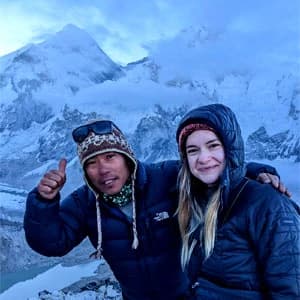
A friend of mine had been using Raj and his colleagues for 11yrs trekking in Nepal. When I decided to visit Nepal again I didn't...
